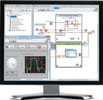

National Instruments has released LabVIEW 2010, the latest version of the graphical programming environment for design, test, measurement and control applications.
LabVIEW 2010 delivers time savings with new features such as off-the-shelf compiler technologies that execute code an average of 20% faster and a comprehensive marketplace for evaluating and purchasing add-on toolkits for integrating custom functionality into the platform.
Introduced in 1986, LabVIEW abstracts the complexity of programming by giving users drag-and-drop, graphical function blocks and wires that resemble a flowchart to develop sophisticated systems. LabVIEW offers integration with thousands of hardware devices, provides hundreds of built-in libraries for advanced analysis and data visualisation and is scalable across multiple OSs and targets such as x86 processors, real-time OSs (RTOSs) and FPGAs. From the LEGO MINDSTORMS NXT robotics kit to the CERN Large Hadron Collider, a large spectrum of users worldwide has adopted LabVIEW.
Key to the productivity delivered by LabVIEW is the compiler, which abstracts tasks such as memory allocation and thread management. The compiler hierarchy has evolved over the lifetime of LabVIEW to become smarter and more optimised. With LabVIEW 2010, the compiler data flow intermediate representation has been further optimised, and Low-Level Virtual Machine (LLVM), an open source compiler infrastructure, has been added to the software’s compiler flow to accelerate code execution. National Instruments has conducted benchmarks ranging from real-world customer applications to low-level functions, and states that the new compiler delivers an average improvement of 20% across these benchmarks.
With the release of LabVIEW 2010, National Instruments is introducing the LabVIEW Add-On Developer Programme to give thousands of partners the opportunity to expand the platform and introduce custom functionality into LabVIEW. The program establishes an online marketplace as part of the updated LabVIEW Tools Network for developers to offer their free and paid toolkits and a comprehensive location for LabVIEW users to browse, download, evaluate and purchase the add-ons. More than 50 add-ons from NI and third-party developers are available, including code re-use libraries, templates, UI controls and connectors to other software packages. Additionally, LabVIEW users can use the VI Package Manager from JKI to connect directly to the LabVIEW Tools Network from their desktop and manage add-on installations and updates.
Additionally, National Instruments has partnered with leading technology providers such as Xilinx to further open up the LabVIEW environment. One example in LabVIEW 2010 is the new IP Integration Node, which makes it possible for users to integrate any third-party FPGA IP into the LabVIEW FPGA Module and offers direct compatibility with cores created with the Xilinx CORE Generator.
During the development of LabVIEW 2010, NI’s R&D department used the new LabVIEW Idea Exchange on www.ni.com/ideas to solicit feature ideas from customers. In addition to submitting new ideas, customers can use the exchange to collaborate on suggestions submitted by others and vote on their favourite features. Fourteen popular submissions from the LabVIEW Idea Exchange were implemented in LabVIEW 2010, including many that improve code documentation and organisation.
LabVIEW 2010 also uses customer feedback to deliver new features that make getting started easier. For example, LabVIEW now provides a new hardware configuration tool that makes it possible for users to access and configure their LabVIEW Real-Time targets remotely via a Web browser. Other features include a smart installer that automatically detects the software associated with a serial number for faster installation and an improved instrument driver finder that offers prebuilt project examples for specific instruments.
For more advanced users and development groups, LabVIEW 2010 includes new features that improve interfaces to re-usable code, group VIs and their hierarchy for faster build times and separate the VI source code from the compiled version to aid in source code management. These capabilities are beneficial for large group development where code maintenance across many users, software versions and computer platforms is critical.
For more information contact National Instruments, 0800 203 199, [email protected], www.ni.com/southafrica
© Technews Publishing (Pty) Ltd | All Rights Reserved